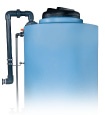Just because different tanks are made from polyethylene, doesn’t mean they will give you the same performance. Various polyethylene tanks may not even be suitable for storing the type of chemical you use. Polyethylene is available in several different types of resin. Some types are made for injection molding, others for extrusion, others for blow molding and yet others for rotational molding.
Topics:
Value Added,
Tank Design and Materials
Barium is a chemical found at relatively low levels in nature, but if it seeps into the drinking water, it can cause a variety of potential health problems. Due to these significant health risks, the Environmental Protection Agency (EPA) has ordered all water treatment plants in areas with higher levels of barium to remove its contents from the water prior to releasing it to the public for consumption.
Topics:
Applications,
Tank Design and Materials
Throughout the country, and even in the global market, the demand for chemicals has led to shortages of many raw materials. At Poly Processing, we’re seeing this occurring in several industries and geographical areas.
Topics:
Tank Design and Materials,
Chemical Storage
A double-wall pipe is an important safety tool when storing liquids, whether it’s chemicals, wastewater, or even liquids used in the food and beverage industry. The vast majority of double-walled piping applications are for wastewater chemicals, contaminated groundwater, and chemical process safety. Double-wall piping systems are used in a variety of ways to protect against leaks. When paired with a SAFE-Tank® system, it makes your storage solution even more secure.
Topics:
Fittings and Accessories,
Tank Design and Materials
You may spend a little more on a Poly Processing cross-linked polyethylene tank, but it could possibly cost much you more to own other tanks. Here’s why.
Topics:
Venting,
Fittings and Accessories,
Tank Design and Materials
If your industrial company produces hazardous runoff from operating equipment, you need to treat the wastewater before dumping it into the sewer or wastewater stream. Depending on your industry, you may need to have a very detailed process that meets the highest standards. Each state and city might have their own standards and regulations you’ll need to meet, or you might be under federal regulations.
Topics:
Chemicals,
Tank Design and Materials,
Chemical Storage
Your double walled tank could be violating the Code of Federal Regulations (CFR) without your knowledge — even if there’s nothing wrong with the tank itself. The CFR contains requirements designed to protect the environment from exposure to hazardous chemicals.
Topics:
Fittings and Accessories,
Tank Design and Materials,
Chemical Storage
Whether you’re an engineer writing a spec for a chemical storage system, or an end-user who is looking for the best way to store corrosive chemicals, there are multiple factors that go into creating a safe storage system. Cost might be your first consideration, but there is more to consider than the initial price of the tank, its fittings and accessories, delivery, installation, and tank longevity.
Topics:
Chemicals,
Tank Design and Materials
Sodium hypochlorite is a chemical used in thousands of applications. As an aggressive oxidizer, it’s critical to limit the opportunity for the chemical to escape the storage tank. If you’re using a polyethylene tank to store oxidizing chemicals, you can multiply the useful life of your chemical storage tank by using an engineered polyethylene antioxidant tank system.
Topics:
Tank Design and Materials
When it comes to choosing a chemical storage solution, you won’t find a more aesthetic option than stainless steel tanks. Steel tanks are popular in breweries and other applications where they’re on public display. The tanks look shiny and clean, and they contribute to the interior design of the space. Steel tanks also have a reputation for being one of the most reliable chemical storage systems on the market.
Topics:
Tank Design and Materials



